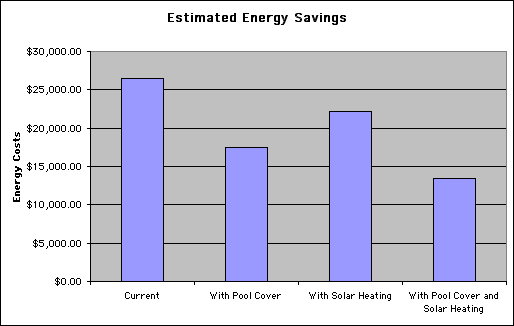
Down the Drain:
Energy Consumption at the Berkeley YMCA Pool
A Vital Signs Case Study
Prof. Alison Kwok/ARCH 507/University of Oregon Architecture Dept.
Design Issues
Program Results
Solar Data
Team Members:
Anne Deutsch
Ram Ganapathy
Geoff Grummon
Design Issues
Data that was collected experimentally was entered into a pool energy estimating program to determine how much energy could be saved by using a pool cover or a solar heating system. Although the program estimated a higher rate of evaporation than we found, it also determined that evaporation could be cut by about 73% if a pool cover is installed and is used every night from 10 PM to 6 AM. According to the program's analysis techniques, approximately 34% of the heating costs for the pool could be cut with a pool cover.

Pool Evaporation Rate from 10 PM to 6 AM
Unfortunately, the deck of the pool is quite narrow, and would not allow passage when it is rolled up. An alternate method of storage, such as a cover that rolls up onto the wall, would need to be designed. Some ideas for a pool cover mechanism are shown here.
The program also analyzed the potential for pre-heating the water with a solar heating system. It found that heating costs could potentially be cut by 16%, but the high cost of the system might make the payback period longer than for a pool cover.
If a pool cover or a solar heating system is installed, an similar case study to ours could be conducted to determine how much energy is being saved.

More detailed information on the results from the program can be found here.
We also collected data on the solar conditions on the roof of the YMCA to explore the possibility of solar heating.